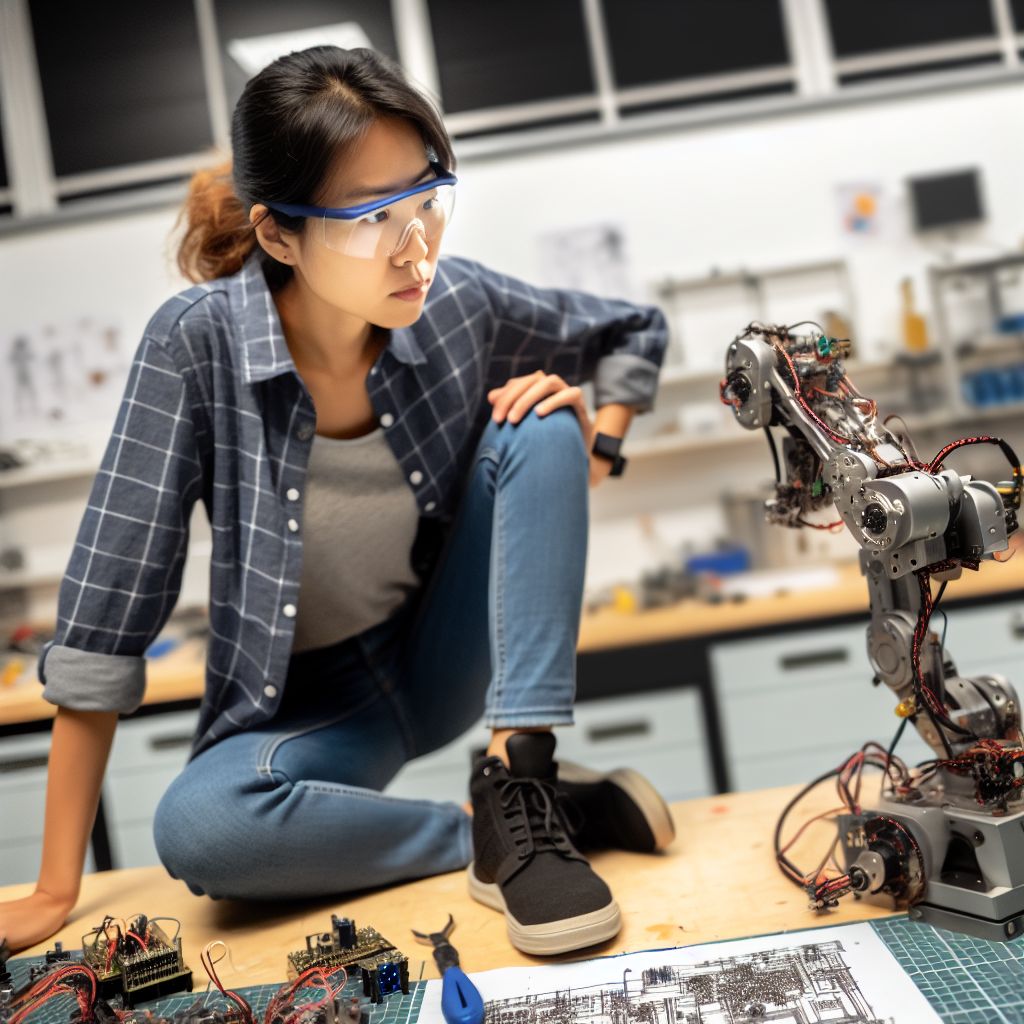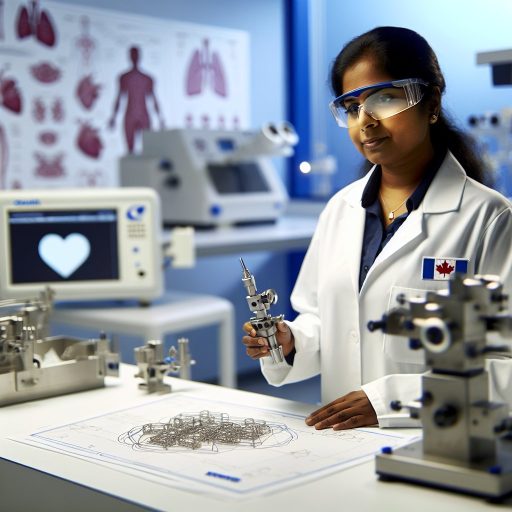Introduction to Robotics and Mechatronics
Defining Robotics
Robotics is the branch of technology that deals with the design, construction, and operation of robots.
Robots are programmable machines capable of carrying out tasks autonomously or semi-autonomously.
They can vary in complexity, from simple mechanical arms to advanced humanoids.
Robotics integrates various disciplines, including mechanics, electronics, and computer science.
Applications range from manufacturing and healthcare to entertainment and exploration.
Understanding Mechatronics
Mechatronics combines mechanical engineering, electronic engineering, computer science, and control engineering.
It focuses on creating intelligent and automated systems.
Examples include robotic systems, automated guided vehicles, and smart devices.
Mechatronics enhances functionality and efficiency in various engineering fields.
This interdisciplinary approach fosters innovation in product development and manufacturing.
Intersecting Robotics and Mechatronics
Robotics and mechatronics often overlap, sharing fundamental principles and technologies.
Both fields emphasize automation and intelligent systems.
They contribute significantly to advancements in industrial automation and smart technologies.
Many modern robots stem from mechatronic principles.
For example, robotic arms used in factories integrate mechanics and electronics seamlessly.
The Importance in Canada
Canada’s growing robotics industry plays a critical role in its technological landscape.
Educational institutions like the University of Toronto and McGill University lead research efforts.
These institutions produce skilled professionals equipped to tackle complex engineering challenges.
Canadian companies, such as Clearpath Robotics, drive innovation in autonomous vehicles.
The government also supports robotics initiatives, emphasizing their potential for economic growth.
The Role of a Mechatronics Engineer in Robotics Fields
Overview of Mechatronics Engineering
Mechatronics engineering merges mechanical, electrical, and computer engineering.
This interdisciplinary field fosters innovation in robotic systems.
It emphasizes design, analysis, and development of advanced technologies.
Key Responsibilities in Robotics
Mechatronics engineers play crucial roles in robotics projects.
They design robotic systems that mimic human actions.
Unlock Your Career Potential
Visualize a clear path to success with our tailored Career Consulting service. Personalized insights in just 1-3 days.
Get StartedThese engineers also develop algorithms for automation.
They collaborate with teams to integrate hardware and software.
Essential Skills for Success
Analytical skills are vital for problem-solving in robotics.
Creativity aids in developing unique robotic solutions.
Strong programming knowledge enhances automation capabilities.
Moreover, mechanical and electrical skills bolster system integration.
A familiarity with sensors and actuators is also essential.
Challenges Faced by Mechatronics Engineers
Mechatronics engineers face numerous challenges in the field.
They often work with rapidly changing technologies.
Staying updated with industry trends is critical.
Moreover, engineers must address safety and ethical issues.
Career Opportunities in Canada
Canada offers diverse career opportunities for mechatronics engineers.
Industries such as healthcare, manufacturing, and automation are thriving.
Many firms actively seek skilled professionals in robotics.
Companies like Clearpath Robotics continuously innovate in this space.
Additionally, research institutions contribute to advancing robotics.
Current Robotics Trends in Canada
Industry Demand
The demand for robotics engineers in Canada is on the rise.
Companies seek skilled professionals to enhance automation.
Industries including manufacturing and healthcare lead in demand.
Moreover, the gaming sector shows increasing interest in robotics.
Canadian universities produce graduates well-versed in this technology.
For instance, close collaborations with local industries foster innovation.
As a result, robotics-related job postings have surged.
Various job platforms reveal a growing need for expertise in robotics.
Innovative Robotics Applications
Canadian startups are innovating across various robotics fields.
Examples include drones for agriculture and inspection tasks.
These technologies enhance productivity and efficiency significantly.
Robot-assisted surgeries in healthcare improve patient outcomes.
Additionally, autonomous vehicles are gaining traction in urban transport.
This diversification showcases Canada’s leadership in robotics innovation.
Local research institutions contribute with groundbreaking studies.
Government funding further accelerates robotics research and development.
Emerging Technologies in Robotics
Artificial intelligence plays a crucial role in robotics advancements.
AI integration allows robots to learn and adapt to new environments.
As a result, machines can perform complex tasks with precision.
Furthermore, advancements in machine learning enhance robotic functionality.
Robotics also benefits from developments in sensor technology.
These sensors improve navigation and interaction with surroundings.
Ultimately, these technologies shape the future of robotics in Canada.
Uncover the Details: Education Requirements for Biomedical Engineers
Educational Pathways: Degrees and Certifications for Mechatronics Engineers in Robotics
Undergraduate Degree Programs
A bachelor’s degree in mechatronics is essential for aspiring engineers.
This program typically includes courses in mechanical engineering, electronics, and robotics.
Students can learn about control systems, sensor technology, and automation.
Furthermore, hands-on projects foster practical skills and problem-solving abilities.
Graduate Degree Programs
Advanced degrees can enhance career prospects in robotics.
A master’s program often offers specialized courses in machine learning and AI.
These programs usually require a research thesis, emphasizing innovation.
Graduate students can develop in-depth knowledge and technical expertise.
Professional Certifications
Obtaining professional certifications can boost credibility in the field.
Certifications like Certified Automation Professional (CAP) can be beneficial.
Other recognized accreditations include the Certified Robotics Technician designation.
These certifications demonstrate expertise and commitment to the profession.
Continuing Education Opportunities
Continuous learning is crucial in the fast-evolving robotics industry.
Short courses and workshops can provide updated skills and knowledge.
Many universities offer online courses focusing on robotics technologies.
Participating in industry conferences can also foster professional growth.
Internship and Co-op Programs
Internships offer invaluable real-world experience for students.
Many engineering programs have partnerships with local companies.
Co-op programs allow students to alternate between study and work terms.
This exposure enhances employability and networking opportunities.
Research and Development Opportunities
Engaging in research can lead to innovative contributions in robotics.
Many universities conduct robotics research with industry collaboration.
Students may assist in exciting projects focused on automation and AI.
Such experiences can refine critical thinking and technical skills.
You Might Also Like: Tips for New Graduates in Chemical Engineering
Key Skills Required for Mechatronics Engineers in the Robotics Sector
Fundamental Knowledge in Engineering Principles
A strong foundation in mechanics is essential for mechatronics engineers.
Understanding dynamics and kinematics aids in designing robotic systems.
Moreover, knowledge of electronics underpins control systems crucial for robotics.
Engineers must also grasp fluid dynamics when dealing with pneumatic systems.
Proficiency in Programming Languages
Programming skills are vital for controlling robots effectively.
Common languages include C++, Python, and MATLAB.
These languages allow engineers to develop algorithms for robotic applications.
Furthermore, familiarity with ROS (Robot Operating System) is advantageous.
Experience with Automation and Control Systems
A deep understanding of automation techniques enhances robot functionality.
Control theory plays a central role in robotics development.
Engineers should implement feedback loops to optimize performance.
Additionally, simulation tools can model control systems before deployment.
Strong Problem-Solving Abilities
Mechatronics engineers must excel in analytical thinking.
They often encounter unexpected challenges during projects.
Creative problem-solving is essential for addressing technical issues.
In fact, collaboration often leads to innovative solutions.
Knowledge of Sensor Technology
Sensors are critical components in robotic systems.
Understanding how to select and integrate sensors is vital.
This knowledge improves robots’ interaction with their environment.
Furthermore, engineers should be proficient in data acquisition techniques.
Collaboration and Communication Skills
Mechatronics engineers frequently work in multidisciplinary teams.
Effective communication ensures all team members understand project goals.
Collaboration fosters a more innovative engineering approach.
Additionally, strong interpersonal skills help in presenting ideas clearly.
Delve into the Subject: Tips for Chemical Engineers Navigating Job Markets

Robotics Applications in Various Industries
Manufacturing
Robotics revolutionizes the manufacturing sector daily.
Busy assembly lines utilize robots for increased productivity.
Robots handle repetitive tasks efficiently and accurately.
Moreover, they enhance safety by performing dangerous duties.
For instance, autonomous robots weld parts together seamlessly.
Companies like Maple Leaf Foods implement robotic processes effectively.
- Improved quality control through precise measurements.
- Expanded production capabilities with minimal downtime.
- Enhanced worker safety through automation of hazardous tasks.
Healthcare
Healthcare increasingly depends on robotics to assist medical professionals.
Robotic surgical systems like the da Vinci offer unmatched precision.
These systems reduce recovery times for patients significantly.
Furthermore, robots help in rehabilitation therapy through tailored exercises.
Robots also play a crucial role in pharmacy automation.
Pharmacies like Shoppers Drug Mart streamline operations with robotic dispensers.
- Diseases are diagnosed more accurately with robotic assistance.
- Robots provide medication reminders for patients.
- Enhanced hospital logistics through automated supply management.
Transportation
Robotics significantly impacts the transportation industry.
Autonomous vehicles are a prime example of this influence.
Companies such as Tesla lead the charge in self-driving technology.
These innovations promise to reduce traffic accidents and improve efficiency.
Additionally, drones assist in delivering packages swiftly.
Amazon utilizes drones to expand its delivery network effectively.
- Enhanced traffic management through AI-driven systems.
- Reduced emissions thanks to improved transportation logistics.
- Increased accessibility for remote areas through drone delivery.
You Might Also Like: Chemical Engineers’ Contributions to the Food Industry
Challenges and Ethical Considerations in Robotics: A Mechatronics Perspective
Technical Challenges in Robotics
Robotics faces significant technical challenges that require innovative solutions.
For instance, designing robots that can operate in unpredictable environments is complex.
Moreover, creating efficient algorithms for real-time decision-making presents difficulties.
Additionally, integrating multiple systems in a robot can lead to compatibility issues.
Robotic systems must be robust against hardware failures and software bugs.
Human-Robot Interaction
Human-robot interaction (HRI) poses unique challenges in robotics.
Ensuring that robots can communicate effectively with humans is essential.
Furthermore, understanding human emotions and responses adds layers of complexity.
Creating intuitive user interfaces helps enhance the HRI experience.
Training users to work alongside robots is crucial for successful integration.
Ethical Implications of Robotics
The development of robotics raises important ethical questions.
One concern involves job displacement due to automation.
Society must address the potential loss of jobs in various sectors.
Additionally, there is the question of accountability when robots cause harm.
Defining the parameters of responsibility is vital for public trust.
Data Privacy and Security
Robots often rely on data collection to function effectively.
This raises significant issues regarding data privacy and security.
Protecting user data from unauthorized access is paramount.
Implementing robust cybersecurity measures can mitigate risks.
Moreover, informing users about data usage is essential for transparency.
Societal Impact and Acceptance
The societal impact of robotics cannot be overlooked.
Robotic technologies can enhance quality of life but may also create resistance.
Public perception plays a crucial role in technology adoption.
Awareness campaigns can help educate the public about the benefits of robotics.
Encouraging dialogue between stakeholders can foster acceptance.
Career Opportunities and Growth Prospects for Mechatronics Engineers in Robotics in Canada
Introduction to Robotics in Mechatronics
Robotics is a core area for mechatronics engineers in Canada.
This field combines mechanical, electronic, and software systems seamlessly.
As technology advances, demand for skilled professionals is growing.
Mechatronics engineers are ideally positioned to take advantage of this trend.
Industry Demand and Employment Landscape
Various sectors actively seek mechatronics engineers in robotics.
Industries include manufacturing, healthcare, and transportation.
For instance, automotive companies frequently adopt robotic systems.
Moreover, healthcare sectors use robotics for surgeries and rehabilitation.
As a result, job opportunities are abundant across Canada.
Trends Influencing Job Growth
Several trends are shaping the job market for mechatronics engineers.
First, automation is increasingly prioritized in manufacturing processes.
Next, artificial intelligence integration enhances robotic functionalities.
Additionally, the push for smart cities increases robotics applications.
These trends create diverse job openings for qualified engineers.
Advancement Opportunities
Mechatronics engineers can pursue various career advancement opportunities.
Senior engineer roles offer greater responsibilities and influence.
Project management positions enable engineers to lead complex initiatives.
Furthermore, transitioning into research and development is possible.
These pathways contribute to professional growth and expertise.
Key Skills for Success
Mechatronics engineers must possess a unique skill set for success.
Strong programming skills are essential for robotics development.
Additionally, expertise in mechanical design and electronics is crucial.
Effective communication and teamwork skills enhance collaboration.
Continuous learning ensures engineers stay current with industry trends.
Educational Pathways
A solid educational background supports a successful career in robotics.
Many mechatronics engineers hold degrees in engineering or robotics.
Hands-on experience through internships is highly beneficial.
Continuing education and certifications can further enhance qualifications.
Emerging technologies courses are particularly valuable in this field.
Additional Resources
Moving to Canada as a mechatronics engineer: How can I transition …
Matthias Preusser – Final Drive Lead – Schulich Off-Road – Baja SAE …




